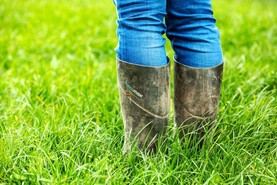Tommy McLaughlin’s farm is located in an exposed area in Ballygorman, Malin Head, Co Donegal. As such, grass growth is generally slower to commence in spring, with soil temperatures tending to remain lower for longer.
The farm is primarily a suckler holding, with the 70-cow suckler herd split evenly between spring and autumn calving. While growth is slower to kick off in spring, ground conditions usually allow the farm to meet a target turnout date for young stock of 20 March and spring-calving cows in early April.
The 100-ewe flock comprises Suffolk, Texel and Belclare genetics and lambs from early March. There is high demand for grass and big pressure on grass reserves to carry stock until growth rates are sufficient to meet demand.
Therefore, Tommy practises a more stringent autumn/winter closing pattern. There was 40% of the farm closed by late October, twice the recommended level for typical mid-season lambing flocks. This additional 20% carried through the closing pattern, with 60% of ground closed by mid-November, 80% by late November and 100% by mid-December.
This closing pattern was vital this winter, with growth rates lower than normal and practically no growth from late November through to February. The farm has an average farm cover of 740kg DM/ha, slightly behind the target of 800kg DM/ha.
The benefit of closing swards early was very evident at the walk, with paddocks closed on 20 October possessing a grass cover of 1,300kg DM/ha (grass height of 9cm) compared with 600kg DM (6cm) for paddocks closed in mid-November and 450kg DM (5.2cm) for those in the first week of December.
Fertiliser was applied at a rate of 25 to 30 units of urea on 23 February. This was the earliest ground conditions allowed, but applying before this would probably have made little difference, with soil temperatures below the 5°C to 6°C required for grass growth. Teagasc sheep specialist Frank Hynes said that getting fertiliser applied once the opportunity presents itself means that nitrogen will be available to help kick-start growth once temperatures rise. This, he says, is of high importance this spring, given how tight grass supplies are likely to be.
There is a strong focus on making top-quality silage to limit winter feed costs from an extended housing period.
The flock scanned 1.84 lambs and twins are supplemented in the final weeks of pregnancy with 0.2kg of a high-protein soya bean-based concentrate, with triplets fed 0.3kg to 0.4kg.
Tommy says that, with this level of supplementation and ad-lib access to silage with a high energy and protein content, there is never an issue with milk yield or lamb birth weight. Ewes and lambs are rotationally grazed, with 80% of lambs finished off grass and concentrates introduced to get the last lambs moved before building autumn grass supplies.
The focus in the suckler herd is on producing top-quality continental cattle, with 15 cows pedigree Charolais (Islandview herd). Cow type is predominately Charolais and Simmental-cross, with Tommy explaining that he has focused on breeding for milk since the herd was set up.
Autumn-calving cows are offered ad-lib top-quality silage over the winter, while their calves are supplemented with 1kg concentrate. Calves are weaned in spring and prioritised for early turnout, with this practice reducing grass demand from letting cows out with calves at foot.
Tommy has tried it both ways in the past and has found calves perform equally well when weaned early, as they can be prioritised with the best-quality grass. Progeny are either sold as forward bulls or brought through to finish.
Tommy said: “Suckler farms are struggling to generate a profit and a payment of €200 is needed to stem an exodus from the sector. The next CAP must also look after active farmers who started farming after the reference year and have a low SFP.”






 This is a subscriber-only article
This is a subscriber-only article










SHARING OPTIONS: